For all the current interest in old-fashioned, do-it-yourself-like-your-grandmother-did-it kinds of food projects (like canning, preserving, pickling), there’s surprisingly little interest in making homemade bread. Maybe you remember that no-knead bread trend that hit a couple of years ago? That lasted, oh, maybe 10 minutes—and it was short-lived, I think, because frankly, the recipe was a pain in the tuchus. And also, frankly, because kneading is the least difficult or time-consuming part of bread-making. (For the uninitiated, no-knead bread, as you might assume, does not get kneaded. You mix a sloggy, wet dough and let it sit overnight, then dump it into a preheated Dutch oven or similar lidded pot. For my money, this dough is difficult to handle, and omitting the kneading didn’t save any time.)
Last week, my brother (who owns Baker & Nosh in Chicago’s Uptown neighborhood and teaches weekly bread-baking classes there) taught me how to make bread. And I’m here to convince you: You can make really good bread at home. For practically pennies. With little time and no fuss. It’s not hard. It’s actually quite fun to make bread. And with his permission, I’m going to share Bill’s easy recipe for homemade French bread.
But first, a couple of notes:
- Get over any ideal of perfection. Don’t try to replicate that perfect loaf of artisan multigrain bread that you bought at the farmers’ market. If you mess up the recipe, you’ll still have good bread.
- For the first couple of times you make bread at home, mix it by hand. This will give you a sense of what the dough should feel like. Plus, it’s messy fun.
- This recipe can easily be halved.
- Fresh yeast is ridiculously difficult to find. But I purchased a few ounces worth from my favorite neighborhood bakery. What’s the difference between fresh and active dry yeast? The former is, well, fresher, and more reliably potent. Can’t find fresh yeast? No problem; active dry yeast is fine. Just buy a new package of it before you start your bread adventure.
- The longer you let homemade bread dough sit after it’s mixed, the better it will taste. This fermentation period develops flavor. The ideal timetable is to mix the dough on Day 1, shape it on Day 2 and bake it Day 3 (keep the dough refrigerated for a slow rise). A two-day timeline is fine: mix on Day 1, then shape, rise and bake on Day 2. In a rush? Do it all on the same day (be sure to allow ample time to rise twice). No biggie.
- Bread flour has a higher gluten content than all-purpose flour, so it’s ideal for bread-baking. I wouldn’t advise using all-purpose flour for bread, but if you have to, knead the dough for a longer time to develop the gluten structure and improve the bread’s texture.
how to make really good homemade French bread
4 cups bread flour
2 1/2 tsp. table salt or 3 Tbsp. kosher salt
2 Tbsp. fresh yeast or 1 package of instant active dry yeast
1 1/2 cups warm water
Measure the flour onto a large butcher-block cutting board or directly onto your kitchen counter. Add the salt and mix the two together with your fingers. Use your hand to make a wide well in the flour (all the way down to the countertop), leaving a rim of about 2 inches of flour. Into this well, sprinkle the yeast, then gently pour in the warm water. Use a fork to dissolve the yeast in the water, then gradually whisk in bits of flour a little at a time. Continue mixing, blending in more flour, until you have a sticky mass; at this point, use a spatula or bench scraper and your hands to mix the dough. (Note: Now, before the dough is fully blended, is the time to add a bit of water if you think it feels too dry. If the dough is too sticky, it’s quite easy to incorporate more flour as you knead.) Use your hands to knead the dough into a ball, then continue kneading, turning and pressing the dough, until it becomes smooth and remains soft. It should feel tacky, like a Post-it note, but should not stick to your hands or to the counter. (If it’s too sticky, sprinkle the dough with a light dusting of flour, and knead to incorporate it.) You’ll be kneading for about 6 or 7 minutes.
Turn the dough into a bowl that you’ve spritzed with cooking spray; cover with plastic. Note the size of the dough ball; you’ll want it to double in size during the fermentation process. The time it takes for this to happen can vary according to a whole bunch of factors, notably temperature. To speed fermentation, place the bowl in an unheated oven with the light on and close the oven door. To slow it down (so you can shape the bread the next day), place the bowl in the fridge.
When you’re ready to shape the loaves, divide it into thirds and shape into rounds or baguettes. (See video below.) Let the shape loaves rise again under a blanket of plastic wrap until they’re about double in size. The dough will be ready when you poke it with your fingertip and the indentation remains. (Again, rising time will vary. Refrigerate the loaves if you want to bake them on Day 3.)
When you’re ready to bake, preheat the oven to 425 degrees. If you have a pizza or baking stone, preheat that in the oven. Place the loaves on a baking sheet lined with parchment, dust them with a light sprinkle of flour, and use a serrated knife to slash the dough at regular intervals. Transfer the loaves to the oven; place them directly on the pizza stone (or place the baking sheet on the stone). Bake for 15 to 20 minutes (baguettes), slightly longer for rounds, until the loaves are deeply golden brown. Remove them from the oven and let cool before slicing.
Enjoy your fresh-baked homemade bread with some homemade salted butter!
Want a quick tutorial on how to shape bread dough into boules, bâtards or baguettes? Watch this video demo:
[youtube=http://www.youtube.com/watch?v=ntFgrWcvMEs&w=560&h=315]
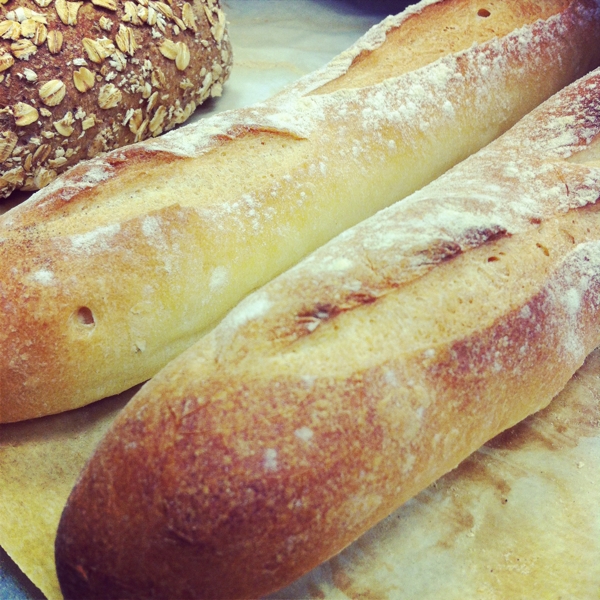
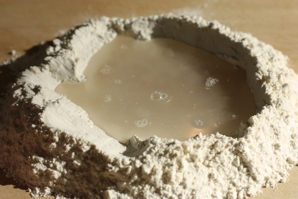
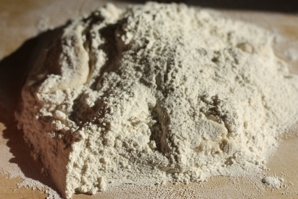
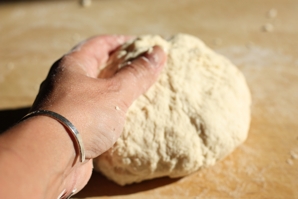
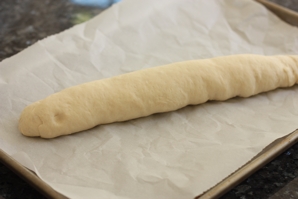





I would love a bread recipe that is 100% whole grain . . .do you happen to have a recipe to share. I did not know you could make bread gradually over 3 days using the refrig. That could work for me as I work full time and don’t have many large blocks of time to make bread.
I love your blog . . . and read it daily.
Thanks so much, Judy
Hi, Judy — thanks for your great comment and for your readership! I do have a whole-wheat bread recipe; however, it isn’t 100% whole wheat. The reason is that whole-wheat flour is lower in gluten-producing protein than all-purpose or bread flour, and so it tends to create bread with a denser, heavier texture. I’ll share with you my brother’s recipe for a basic wheat bread dough; I made this and it was hearty and delicious.
Starting with this basic whole wheat bread recipe, you can incorporate other whole grains and seeds if you like: sunflower seed, pepitas, sesame seed, flax (whole or ground), rolled or steel-cut oats, cornmeal, wheat berries, millet … you get the idea. The more “stuff” you add, the denser the bread will be, and you’ll likely need to add a bit more warm water as you mix the dough.
This bread can be fermented, shaped and baked as the basic white bread recipe above.
Basic Wheat Bread Dough Recipe:
2 cups bread flour
2 cups whole wheat flour (or white whole wheat flour)
2 1/2 tsp. table salt or 3 Tbsp. kosher salt
2 Tbsp. fresh yeast or 1 package active dry yeast
1 1/2 cups warm water (more if needed)
Judy, if you make this wheat bread recipe, please let me know how it turns out by commenting here!
Bryn
LOVE THIS. More bread recipes! I just started baking my own bread weekly and am obsessed with how easy it actually is, and how GREAT the results can be. (The smell in our home is great, too.)
Yay Lisa! I know, right? It’s not difficult to make a simple bread dough at home. And I was literally giddy when I pulled my baguette out of the oven and saw how nicely it came out. It’s quite a satisfying thing to do. And fun for kinds, right? Thanks for your comment!
BTW, see the other comments on this post; I’ve added a recipe for basic wheat bread, and it’s equally easy and delicious.
Bookmarked! This looks too simple (though I’m picturing the water seeping out from under the flour walls and running down the front of my cabinets) not to try. Thanks!
Ok Bryn, today’s the day I get the ingredients and start the process to make my own bread. I have had zero to bad luck in the past. You’ve made it seem so easy, I simply MUST try it. Thanks for your optimism, and wish me luck! =)
Good luck! And report back on how your homemade bread turns out, Cami. Thanks for your comment!
Do you have a good recipe for sweet rolls like those you get at O Charleys? Would love to have it. Deb
Hi, Deb — I’m not familiar with the dinner rolls at O Charleys … sorry! But I did a quick Google search and found several recipes online. This one looks promising:
http://community.tasteofhome.com/community_forums/f/32/t/82.aspx
Pingback: Best recipes of 2012. | writes4food | recipes and wisdom from a Midwestern kitchen